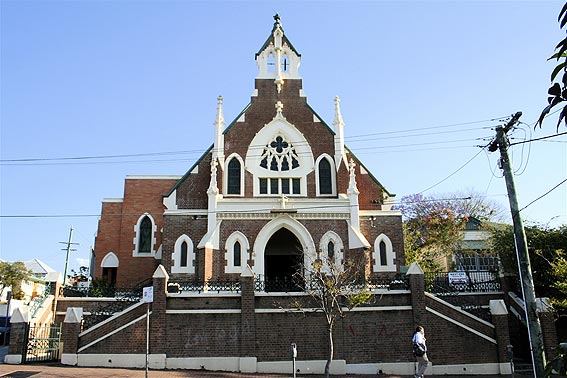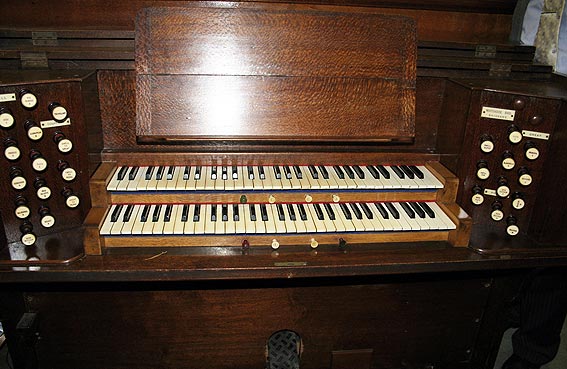
West End Uniting Church
[Photograph by Trevor Bunning (September 2007)]

West End Uniting Church
[Photograph by Trevor Bunning (September 2007)]
Historical and Technical Documentation by Geoffrey Cox
© OHTA 2007, 2011, 2012 (last updated June 2012)
The foundation stone of the Wesleyan Church at West End was laid on 10 January 1885, and the church was opened with special services on 15 November 1885.1 The building was designed by the Scottish-born architect, Alex. B. Wilson (1857-1938), shortly after Wilson had set up his own architectural practice in Brisbane.2 The first organist of the church, Mr W.D. Steele is said to have 'presided at an organ purchased from Albert Street Church.'3 This was obviously a reed organ. It was replaced successively by three pipe organs,4 in 1901, 1909 and 1924 respectively.
First Organ.
The first pipe organ, built by the Positive Organ Company Ltd, London, had come from Holy Trinity Church, Mackay. It was installed at West End in 1901,5 and subsequently found its way to St Philip's Anglican Church, Annerley, where it was destroyed by fire in 1954.
Second Organ.
The second organ was a mechanical-action instrument built in 1909 by B.B.Whitehouse & Co. of Brisbane. It was opened at West End on Wednesday 31 March 1909,6 and later sold to Holy Trinity Anglican Church, Fortitude Valley, where it was installed in 1924.7 It has subsequently been rebuilt and enlarged.
Present Organ.
The present organ at this church was built by Whitehouse Bros of Brisbane,8 and was opened on Sunday 25 May 1924. It was the gift of Mr Robert J. Archibald, organist and choirmaster of the church for many years. Mr Archibald had previously been organist at the Neil-street Methodist Church, Toowoomba, around 1898. His memorial plaque at West End records that he died on 1 August 1939.
An announcement of the opening reveals that the installation of the organ involved alterations to the interior of the church to the design of the noted architect, Lange Powell:
A GIFT ORGAN.
A magnificent organ built by Mr Whitehouse, has been given to the West End Methodist Church by Mr R. J. Archibald, the church organist and choirmaster, and on Sunday the instrument will be opened with special services, morning and evening, by the Rev. B. Frederick and the Rev. H. H. Trigge, M.A. The whole of the choir gallery and pulpit has been built under the supervision of Mr. Lange Powell, architect, by Mr. Stainfeld, contractor. The organ and gallery are in silky oak, and an electric motor supplies the air. A special choral service will be held at 3 p.m. on Sunday, when Mr. Archibald will contribute organ solos, the choir will sing anthems, and Misses Lena Hammond, R. Barrett, D. Wilde, E. Taylor, and Rev. A. Lewis, Messrs R. L. Wishart, S. Tamblyn, and V. Cooling will contribute solos. On Thursday night Dr. Jarman will give an organ recital, and Mrs. Jarman will be soloist for the evening.9
The collaboration between Whitehouse Bros and the architect, Lange Powell, appears here to have been similar to that which occurred later in 1924 at St Andrew's Presbyterian (now Uniting) Church, Warwick, where both the pulpit and the organ case were designed by Powell. The case at West End, insofar as it remains visible, shows similarities to that at Warwick, neither being typical of the general Whitehouse style. A plaque on the organ case still records Archibald's gift:
Presented to the Trustees and Congregation
of the West End Methodist Church
by R. J. Archibald Esq 25.5.24.10

Organ casework, pulpit and other furnishings, designed by Lange Powell
[Photograph by John Maidment (September 2007)]
The opening of the organ was reported in The Brisbane Courier on the Monday following.11 The specification given on this occasion differs only slightly in nomenclature from what now appears at the console, and it lacks any reference to the 16ft stop on the Great. This omission may result simply from the fact that it is borrowed from a Pedal stop (see below).
Following the dedication and opening, an organ recital was presented on the Thursday night by Dr C.A. Jarman, who was at that time organist of St Mark's Anglican Church, Warwick. Jarman provided a glowing testimonial, comparing the West End instrument favourably with the slightly smaller Whitehouse organ installed around a year earlier at St Mark's:
Brisbane
Thursday Night 11 P M
29/5/24
Dear Mr Whitehouse,
I feel that I want to write and congratulate you on the excellent Organ that you have supplied to the West End Methodist Church, upon which I gave the recital to-night. The quality of tone is really delightful, and as regards the action, well I can only repeat of it what I have found with the Organ at St Mark's Warwick. It is as near perfection as can be obtained.
It has been more than a pleasure to give the recital tonight and after a good deal of experience of work of almost all the Organ Builders in Australia, I am only firmer in my sincere conviction "Whitehouse" first.
With kindest regards.
Sincerely yours,Chas A. Jarman.
MusD. L.Mus Lond.
(Late Organist of Bathurst, N.S.W. Cathedral).12
This instrument was one of the larger tubular-pneumatic organs built by the Whitehouse firm in Queensland. The specification, of 19 stops, is around the same size as St Mary's, Ipswich (1915, with addition c.1917), and two stops larger than St Brigid's, Red Hill (1914). The differences in tonal design from the earlier instruments, however, are interesting: As at St Mark's Warwick a year earlier, there is now a general shift towards more foundation tone, with three Pedal stops and nothing above 4ft stops on the Great. The 16ft manual flue stop now appears on the Great rather than on the Swell. These trends were evident later also in the large Whitehouse pneumatic instruments at The Southport School (1925) and at the Masonic Temple, Brisbane (1930).

[Photograph by Trevor Bunning (September 2007)]
At some time after 1972, when the specification was first recorded as below, the console at West End was moved by Walter Emerson of Toowoomba to its present detached position.13 It was presumably also at this time that the original trigger swell was replaced by a balanced one, and that the middle flat of pipes in Powell's case was covered by a screen.
The organ was restored in 1991-92 by W. J. Simon Pierce, retaining cone tuning.14

Console of the Whitehouse organ
[Photograph by Trevor Bunning (September 2007)]
| GREAT Bourdon Open Diapason Dulciana Clarabella Principal Flute SWELL Open Diapason Salicional Voix Celeste Gedact Gemshorn Flute Piccolo Cornopean Oboe Vox Humana PEDAL Bourdon Echo Bourdon Bass Flute COUPLERS Swell to Pedal Great to Pedal Swell to Great Swell Super Swell Sub |
16 8 8 8 4 4 8 8 8 8 4 4 2 8 8 8 16 16 8 |
A B A B [acting through to Great] [acting through to Great] |
Detached draw-stop console
3 combination pistons (& cancel) to Great Organ
3 combination pistons (& cancel) to Swell Organ
Radiating concave pedalboard
Hitchdown lever swell [replaced by balanced swell pedal after 1972]
Tremulant
Compass: 61/30
Tubular-pneumatic action.15
The stop jambs suggest that two further stops may have been envisaged on the Great organ.


The stop jambs of the Whitehouse organ
[Photographs by Trevor Bunning (September 2007)]

Pipework of the Great Organ
[Photograph by John Maidment (September 2007)]

Pedal Bourdon and action
[Photograph by John Maidment (September 2007)]
____________________________________________________________________________
1 The Telegraph (12 January 1885), p. 5; "Diary of Events" for 15 November 1885 in Pugh's Queensland Almanac . . . for 1886.
2 Donald Watson & Judith McKay, Queensland Architects of the 19th Century: A Biographical Dictionary (Brisbane: Queensland Museum, 1994), pp. 208-09.
3 Diamond Jubilee . . . Anniversary Celebrations (November 1945) – booklet supplied to G. Cox by the Methodist Historical Society, courtesy of Rev. Alan Heiner, 20 Sept. 1974.
4 Fortieth Anniversary of the West End Methodist Church, Nov. 8th, 1925, p. 10 - booklet supplied to G. Cox by the Methodist Historical Society, courtesy of Rev. Alan Heiner, 20 Sept. 1974.
5 The Brisbane Courier (4 October 1901), p. 6.
6 The Brisbane Courier (30 March 1909), pp. 2, 6.
7 Fortieth Anniversary, op. cit., p. 10; Centenary Booklet, Holy Trinity Parish Fortitude Valley Centenary Celebrations 1856-1956; Minutes of Parochial Council Meetings, Holy Trinity Church, Fortitude Valley (August 1924 & December 1924).
8 Whitehouse Bros Ledger (1922-40), p. 114; Fortieth Anniversary, op. cit, p. 10.
9 The Brisbane Courier (Friday, 23 May 1924), p. 6. See also: R. S. C. Dingle, Annals of Achievement: A Review of Queensland Methodism, 1847-1947 (Brisbane: Queensland Book Depot, 1947), p. 226.
10 Noted by G. Cox, September 2007.
11 The Brisbane Courier (Monday, 26 May 1924), p. 8.
12 Copy of letter from C.A. Jarman, 29/5/24, supplied to G. Cox from the records of Messrs Whitehouse Bros, c.1974.
13 Personal communication to G. Cox from Simon Pierce, July 2007.
14 The Organ Voice, vol. 19, no. 2 (October 1991), p. 33; The Organ Voice, vol. 19, nos 5 & 7 (April & August 1992), back covers; The Organ Voice, vol. 19, no. 6 (June 1992), p. 39.
15 Specification noted by G. Cox, 1972 & 2007.

[Photograph by Trevor Bunning (September 2007)]